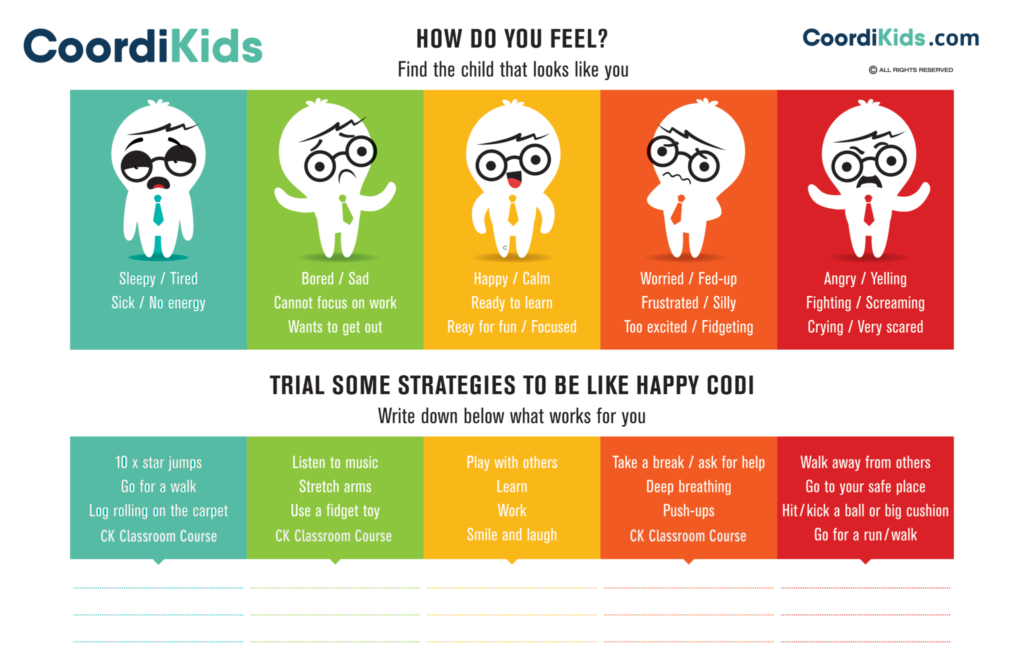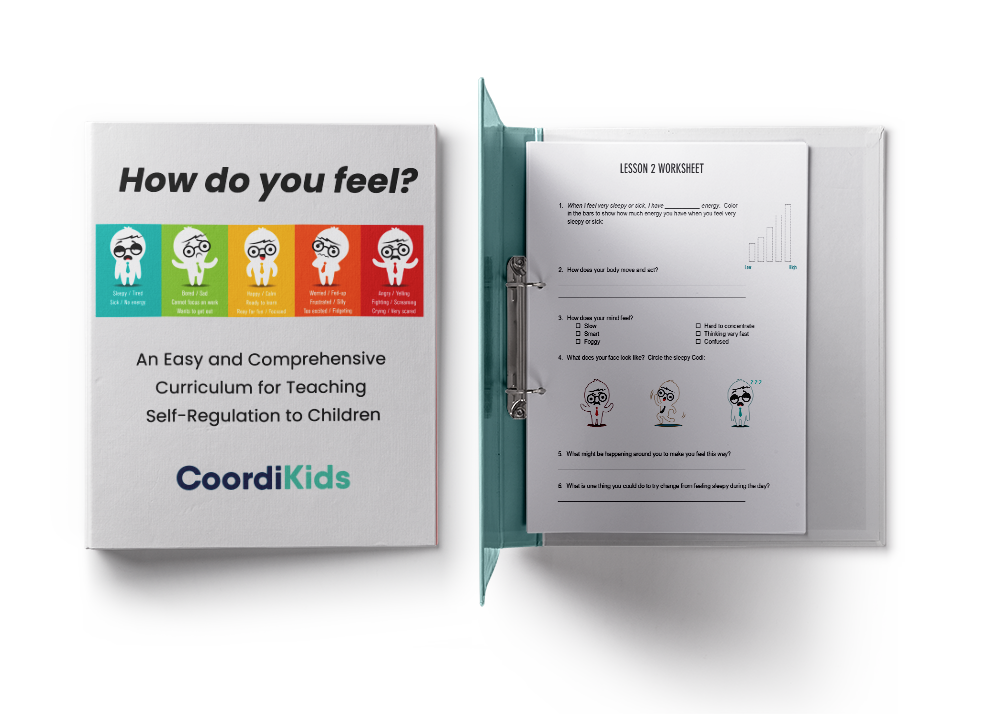Free Downloads & Checklists, Help for School and Kindy
An Easy and Comprehensive Curriculum for Teaching Self Regulation in Children
One of the most important lessons for our kids to learn is that of self-regulation. Children struggle with managing their emotions on a daily basis as they interact with family, friends and teachers.
So, this month, we’re focusing on offering strategies to elementary school teachers for teaching self-regulation in children.
A few months ago, we introduced a brand new tool for parents and teachers to use when discussing emotions and self-regulation with children. The “How Do You Feel?” Chart is a visual aid that categorizes 5 different emotional states.
Then, with the help of our friend Codi, the chart describes each emotional state. It also offers tips for helping children transition from one end of the emotional spectrum to a more neutral, calm and happy state.

Now, we’re happy to announce the next development in our series of downloadable tools for teachers: The How Do You Feel? Curriculum for teaching self-regulation to children.
How Do You Feel? is a curriculum designed for elementary school teachers. The kit is geared toward helping children ranging in ages from 4-12, or in the following grades, respective to region:
UK teachers of Preschool, FS1, Key Stage 1, or Years 1 – 9 : fulfilling portions of the UK Core Curriculum: Personal, Social, Health & Economic Education non-standardized recommendations.
Australian teachers of Preparatory, Kindergarten – Primary School : fulfilling portions of the Australian Core Curriculum: Health & Physical Education (ACPPS017, ACPPS020, ACPPS034, ACPPS038, ACPPS054)
American teachers of Preschool, Pre-K, or Elementary School : fulfilling US Core Curriculum: Physical Health Standards (NPH-H.K-4.1, NPH-H.K-4.5, NPH-H.5-8.5)
South African teachers of Kindergartens and Elementary Schools, Grade R: Grade 6: fulfilling portions of Life Skills components for Grades R-6

We’ll send you a copy of the full curriculum to your email inbox:
Why Teaching Self-Regulation to Children is Important
The aim of teaching self regulation to children is to help students to put a name with the emotions they feel. Once we can name our emotions, it’s easier to know what to do next.
Once children’s emotions are identified it’s easier to work their way back to a state of calm and happiness. Having conscious awareness of emotional states and the ability to regulate their emotions in various situations in powerful.
It gives students a valuable toolbox to take with them throughout life. Teaching self regulation children can benefit from their entire lives is one of the greatest things we can do for them.
What’s Included: The How Do You Feel? Curriculum from CoordiKids
- The “How Do You Feel?” Chart
- 6 Lesson Plans
- Visual Aids
- Exploratory Questions
- Cognitive Learning Strategies, such as repetition, summarizing, guessing, etc.
- Self Regulation Activities for Children to Participate In
- Worksheets for Student Completion
- A Printable How Do You Feel? Chart for Each Student to Personalize
The How Do You Feel? Curriculum & Self-Regulation Activities for Children
Within the How Do You Feel? Curriculum, we’ve included 6 lesson plans that can be integrated with complete flexibility into your teaching plan. Complete them all at once or divide them over the course of a week or more.
Each lesson includes:
- Reading facial expressions, body language, and situational context to identify emotional states
- How we observe and react to each other’s expressions, body language, and emotional reactions
- Types of situations that elicit various emotional responses
- When it might be useful to change emotional states
- Different strategies for changing emotional states
The kit also includes self-regulation activities for kids to actively practice. So they can practice the tools Codi suggests for transitioning from one emotional state to another.
Each activity has been supported by scientific research to make significant changes in a child’s ability to self-regulate. But, as every child is different, it’s important to trial various types of emotional regulation activities to see which benefits each student the most.
Then, students can write down the most effective techniques on their personalized “How Do You Feel?” Chart.
Activities such as:
- Physical exercises
- Calming Techniques to trial
- Proprioceptive Activities
- Vestibular Activities
- Sensory Activities
For Self Regulation Children Are Empowered By
The How Do You Feel? Curriculum and kit of self-regulation activities for kids is a tool we are really proud to offer teachers.
Our team of pediatric occupational therapists, early childhood development specialists, and the CoordiKids Village of parents and teachers work hard to ensure that everything we provide is something backed by scientific research and proven by our own experience.
We hope you’ll enjoy it and adopt it as part of your own curriculum!
If you use this tool, please join us at the CoordiKids Facebook Page to tell us how the various lessons and exercises went for your class. We’d love to hear successes! Also, we’d love to find out how we can adjust the tools to work best for everyone!
We’ll send you a copy of the full curriculum to your email inbox:
Do you have any online curriculum resources for teachers to use to teach self regulation strategies. If you do, can you please send me a quote per teacher for the online resources including if it has to be renewed yearly.
Thank you
Kellie
Hi Kellie!
I presume you’ve already downloaded the lesson plans and worksheets linked in this article for the self-regulation strategies? Beyond that, the CoordiKids Classroom Course is our online resource – it includes daily exercise videos that students follow as movement breaks. These exercises are targeted to help students with regulation for the time periods following the physical activity. Many teachers are thrilled with the changes in students’ behavior and ability to focus immediately following the daily movement breaks offered in the Classroom Course.
Hi Kellie!
I presume you’ve already downloaded the lesson plans and worksheets linked in this article for the self-regulation strategies? Beyond that, the CoordiKids Classroom Course is our online resource – it includes daily exercise videos that students follow as movement breaks. These exercises are targeted to help students with regulation for the time periods following the physical activity. Many teachers are thrilled with the changes in students’ behavior and ability to focus immediately following the daily movement breaks offered in the Classroom Course.